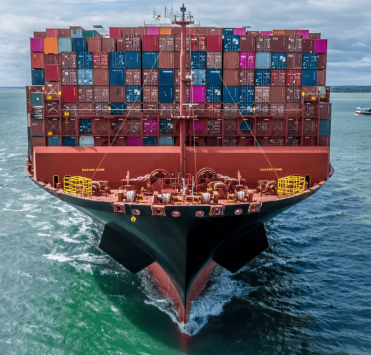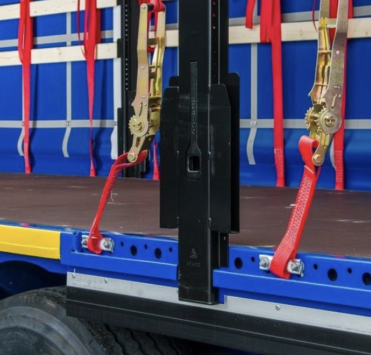Maritime container shipping: 10 steps to efficiency

Maritime container shipping to Ukraine remains one of the most reliable and in-demand ways to deliver cargo from abroad. The reason for this popularity is their versatility, affordable cost and relatively high level of safety. Container shipping allows transporting various types of cargo - from foodstuffs and industrial components to large-sized equipment, which makes this method of logistics particularly flexible.
However, to avoid unforeseen costs, delays and unnecessary risks, it is worthwhile to understand all the nuances of organizing sea freight to Ukraine in advance. Below are 10 key questions that are important to answer before sending cargo across the ocean or sea. These tips will help you optimize delivery times, prepare the necessary customs documents and reduce overall logistics costs.
1. Which container to choose? Container options for sea container shipping to Ukraine: features and selection criteria
When planning sea container shipping to Ukraine, it is important to choose the right type of container, because it depends not only on the cost of delivery, but also the safety of your cargo. Below we will consider the main variants of containers, which are most often used for delivery of goods by sea, and will also consider the key selection criteria, allowing us to determine the optimal container for your goods.
20' DC container.
- Optimal for heavy goods in a smaller volume: can hold up to 28-30 cubic metres of cargo without exceeding the weight limit.
- Suitable for most standard cargoes: these containers are versatile and protect goods from external influences during sea transport.
- Saves on logistics: due to its compact size, renting a 20' container is cheaper if the volume of goods is not too large.
40' DC container.
- Advantageous for bulky but relatively lightweight goods: excellent for large consignments where weight is not critical.
- Increased capacity: holds almost twice the volume of a 20' container.
- Universal business solution: suitable for entrepreneurs who regularly deliver large volumes of goods (furniture, textiles, household appliances, chemical raw materials, feed additives, etc.).
Refrigerated containers
- Necessary for goods requiring temperature control: foodstuffs, medicines, cosmetics and other perishable goods.
- Maintaining a set temperature: the in-built refrigeration unit ensures a stable temperature throughout the entire sea freight journey.
- Compliance with quality standards: such carriage guarantees the preservation of trade dress and properties, which is especially important for foodstuffs or medicines.
Open-top / Flat-Rack
- For oversized cargo: large industrial equipment, machinery and other non-standard goods that are difficult to fit in a classic container.
- Special design: the Open Top has a removable roof for easy top loading, while the Flat Rack is a platform without side and top walls.
- Logistical flexibility: allows the transport of cargo that exceeds the standard dimensions, while ensuring a secure and safe sea voyage.
Selection criteria
- Cargo volume and weight: First of all, assess how many cubic metres the cargo will occupy and its total weight. A container that is too small may risk damage to the goods due to cramped loading, while a container that is too large will result in unused space and unnecessary costs.
- Temperature requirements: If goods require special storage conditions (e.g. foodstuffs or pharmaceuticals), you will need refrigerated containers or special conditions to maintain the right temperature.
- Characteristics and shape of the goods: Oversized parts, industrial equipment or irregularly shaped goods are easier to transport in open-top or flat-top containers. It is important to take into account the possible customs clearance requirements for oversized goods.
The choice of a suitable container for sea transport directly affects the cost of freight, delivery time and the level of cargo safety. Therefore, determine the exact cubic volume and weight in advance, take into account the nuances of your goods and consult with a reliable logistics company. Professionals will help you choose the best container, prepare all the necessary documentation for import to Ukraine and calculate the exact logistics costs, avoiding unnecessary costs and delays.
Thus, a competently chosen container and the correct organization of container shipping will allow your business to efficiently deliver goods from anywhere in the world, preserving the quality of cargo and optimizing logistics costs.
2. What documents are required? The basic list of documents for sea container transport to Ukraine
When organizing sea container transport it is extremely important to pay special attention to the correct execution of supporting documentation. Any inaccuracies or omissions in the paperwork can lead to delays, additional costs and even confiscation of cargo at customs. Below is a basic list of documents required for customs clearance and successful delivery of cargo by sea.
- Bill of Lading (Bill of Lading)
- The main document that confirms ownership of the cargo.
- It contains key information about the point of origin and destination, carrier and consignee.
- Without a properly executed Bill of Lading, it is impossible to complete customs clearance and receive the shipment.
- Invoice and Packing List.
- Reflects the name, quantity of goods, value and terms of payment.
- The Invoice is the basis for calculating customs duties and taxes.
- The Packing List details the contents of each item and assists customs authorities in inspecting the shipment.
- Export Declaration
- Confirms the legality of exporting goods from the country of origin.
- It is important for international trade compliance and serves as proof of origin.
- A properly executed export declaration is necessary to avoid problems during customs clearance in Ukraine.
- Certificates (quality, origin, etc.)
- Depending on the type of cargo, additional permits and certificates may be required (e.g. veterinary and phytosanitary certificates for foodstuffs).
- Certificates of conformity and safety are often requested for technical or industrial equipment.
- Check with customs brokers in advance to find out exactly what documents are required for your type of goods.
Why is it important to check the accuracy and completeness of documentation?
Correct and timely completion of all paperwork is one of the key factors in the successful delivery of goods by sea. Errors in documents or their incomplete list usually lead to:
- Downtime of cargo in the port and additional storage costs;
- Fines imposed by customs authorities;
- Longer delivery times and, in rare cases, confiscation of the cargo.
To avoid such risks, agree all details in advance with customs brokers and freight forwarders specializing in container shipping. They will help you clarify the specific requirements for each type of goods and prepare a full set of documents for customs clearance in Ukraine.
3. What are the customs requirements in Ukraine?
Customs procedures are often complicated for companies that have no experience in international trade. The main points are:
- HS code (commodity nomenclature): Each commodity is assigned a code by which duties and taxes are calculated.
- Duty and VAT rates: Depends on the HS code and can vary considerably.
- Certificates required : Certificates of conformity are required for a number of goods (e.g. foodstuffs, machinery, medical devices).
It is important to find out in advance what documents and permits will be required, as well as the exact rates of duties and taxes, in order to create a realistic cost estimate.
4. How to calculate the delivery time? Timing of containerized sea freight to Ukraine: key factors and recommendations
When planning container shipping to Ukraine, one of the most important tasks is to accurately determine the delivery time. However, even with detailed planning, delays caused by external circumstances are possible. Below we will consider the main factors affecting the speed of container transport and give some tips on how to avoid unpleasant surprises.
1. Distance and route
- Directly or via transit ports: A container can go directly to Ukraine or with transshipment in intermediate ports (e.g. Turkey, Poland or Romania). The choice of route has a direct impact on delivery time and cost.
- Route logistics: The more transshipment points there are, the higher the risk of delay at each of them. If you want to reduce journey times, favour more direct routes.
2. Weather conditions and port congestion
- Weather factors: Storms, strong winds and unfavourable sea conditions can slow down or temporarily stop a ship's movement. This is especially true during autumn and winter.
- Terminal congestion: Congested ports and strikes by port infrastructure workers can lead to longer unloading and onward dispatch times.
In order not to miss critical deadlines, study the schedule of ship calls in advance and check the congestion of a particular port. Sometimes it is more favourable to choose another port where the waiting time will be shorter.
3 Customs delays
- Errors in documents: If there are inaccuracies in the bill of lading or invoice, customs authorities may conduct additional inspections or require revision of the documents. This increases the overall delivery time.
- Certification difficulties: If your shipment requires certain permits and certifications, the absence of these documents can lead to delays at customs.
No matter how you plan to ship your cargo by sea, there is always the possibility of unforeseen circumstances. That is why professional logisticians recommend that you allow 1-2 weeks extra time for delivery. This allows you to compensate for delays caused by weather conditions, overloaded terminals or inaccuracies in documentation, and not to violate the overall logistics timeline.
5. Distance and route
- Direct route
- If a container is sent directly to Ukraine without transhipment, you minimize the risk of delays due to overloading or queues at intermediate ports.
- Direct routes are usually shorter in time, reducing the likelihood of incurring additional storage costs.
- However, it is not always possible or cost-effective to use a direct route, especially if the shipment is originating from remote regions where infrastructure may be limited.
- Transit ports (e.g. Turkey, Poland or Romania)
- Advantages: More developed port infrastructure, frequent ship calls and potentially lower freight rates.
- Disadvantages: Additional transshipment can delay overall shipping times and increase the risk of delays. In addition, additional charges may be levied at each transshipment point.
- Transit through other countries is sometimes the only available solution, especially if there are temporary restrictions or logistical difficulties in the area of the nearest ports.
6. Weather conditions and port congestion
Weather factors and terminal congestion: how to avoid delays in containerized maritime transport to Ukraine
When planning sea container shipping to Ukraine, it is important to consider not only the route and timing, but also external conditions that can affect the speed of delivery. Unfavourable weather and busy terminals can lead to vessel downtime. Below we look at why these two factors are so critical and how to minimise the risks.
- Seasonality: During autumn and winter, storms, strong winds and high waves are not uncommon in the Black Sea. These conditions can significantly slow down or even temporarily stop the vessel's movement.
- Ship and cargo safety: When weather conditions become extreme, captains often choose a longer but safer route. This can increase overall delivery times and result in additional costs.
Monitor weather forecasts and account for seasonal variations in shipping line schedules. Include a small time allowance (1-2 weeks) in your logistics plan in case of force majeure.
7. What costs can be incurred other than freight?
When planning container shipping, many companies focus mainly on freight costs, but forget to take into account a number of mandatory and associated costs. This short-sightedness can lead to serious budget overruns and disrupted financial plans. Here are four main categories of costs that are important to keep in mind when organizing freight delivery.
1. Port charges
- Cost composition: charges for the use of port infrastructure, loading and unloading services and movers.
- Peculiarities: port charges may vary depending on the specific port, sea line and season. For example, ship and container handling fees may increase during peak periods.
To avoid overspending, it is worth checking rates at your chosen port in advance or considering alternative options (other terminals or ports in neighbouring countries).
2 Customs duties and taxes
- Calculation: the amount of customs duties and taxes (VAT, excise duties) is directly related to the HS code and customs value of the cargo. Incorrect identification of the code may lead to underestimation or, on the contrary, overpayment.
- Importance: Customs duties can be a significant expense, especially when importing bulky or expensive goods.
Determine the exact HS code for each item. Check current duty and tax rates on the official customs website or with customs brokers.
3. Cargo Insurance
- Insurance rate: Usually 0.1-0.3% of the declared value of the shipment, but the exact rate depends on the category and vulnerability of the goods (e.g. fragile goods or electronics).
- Why it's important: Insurance protects against losses in case of damage or loss of cargo due to unforeseen circumstances (storm, ship accident, force majeure in port, etc.).
Familiarize yourself with the insurance company's terms and conditions, including exclusions from coverage. Compare offers from several insurers to find the best balance of price and level of protection.
8. Cargo insurance
Many shipping companies sometimes neglect to take out insurance cover in order to save money. However, this approach can lead to serious losses if the container is damaged during loading, unloading or as a result of unfavourable weather conditions (storms, strong winds, wave heights). Unlike road transport, where damage may not be so extensive, the risk is greater at sea, as a sea vessel may be caught in a strong storm, encounter rocking or emergency situations.
The main risks covered by insurance are:
- Loss of cargo: when a container is lost or thrown overboard in a severe storm.
- Partial damage: when the goods inside the container are damaged due to water ingress, impact or improper securing during transport.
- Force Majeure: this includes fires on the ship, collisions, pirate hijackings and other unforeseen situations.
Cargo insurance for shipping is a reliable way to protect your business from major financial losses. Even if the likelihood of incidents is low, the consequences can be catastrophic without proper protection.
9. How do I prepare my cargo for transport?
- Secure packaging: Using a sturdy wooden or plastic pallet, wrapping (stretch wrap, shrink wrap).
- Labelling: Indication of the recipient's address, port of destination, information about the goods (fragile, breakable, hygroscopic, etc.).
- Safe docking inside the container: If the cargo is not securely fastened, it may move around inside the container during sea currents.
The quality of the packaging determines the safety of the cargo. Pay special attention to this, especially for valuable or fragile goods.
10. How to find a reliable partner for sea transport?
Choosing a logistics partner is one of the most important stages in organizing container shipping to Ukraine or other countries. Not only delivery time, but also correct execution of documents, cargo safety and minimization of risks depend on the carrier's professionalism. To make the right decision, it is worth considering several key criteria.
Reputation of the company in the field of maritime logistics: Firstly, study reviews of the logistics company. Check out customer opinions on specialised platforms and social media. Real cases, ratings and recommendations will help you understand whether you should trust a particular logistics company.
Pay special attention to the company's experience. Find out how long it has been in the market, what routes and ports it has had to deal with. Companies with a wide geography of deliveries and a long track record usually provide
Transparent billing system: A reliable logistics company always offers a detailed price quote. Such a price includes:
- Freight
- Port charges
- Additional charges (e.g. storage or insurance).
Pay attention to the absence of hidden charges. A conscientious logistics operator will never ‘add on’ additional services without prior agreement. To make sure that the rates are adequate, request quotations from several companies and compare them. This will help you identify which rates are in line with the market and which may be overpriced.
Timely feedback and professionalism: Companies with a high level of professionalism help you solve complex problems, including:
- Preparing documents for customs clearance;
- Selecting the optimal delivery route;
- Arranging insurance coverage for the shipment.
Flexibility and individual approach to each client also play an important role. Companies focused on long-term co-operation actively invest in staff training and improvement of internal processes, which improves the quality of services.
Save Pro Solutions has many years of experience in organising container shipping to Ukraine and other countries. We provide a full range of services: from selection of the optimal route and preparation of documents for customs clearance to cargo insurance and operational tracking of deliveries. Professional approach, attention to detail and customer focus make Save Pro Solutions a reliable partner in international logistics. Entrust your transport to the experts to be sure of quality and on-time delivery!









